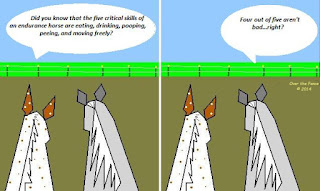Probably the most important thing you can learn riding endurance is that you must really know your horse. Must know when the horse is okay and must know when something is not quite right (NQR). The ride vet knows certain metabolic parameters that benchmark a horse having a bad day. But they do not know your horse. It is possible to get through a vet check and have an underlying problem. This is where knowing your horse might save the day. You’ve trained a lot of miles and should have a feeling for what your horse’s normal is, and when something seems off (appetite, brightness, willingness to move forward on trail, dull or worried eyes, lack of thirst, anything NQR) it is time to pull the plug on your ride and call it a day. Taking a horse out on one more loop that is NQR may have catastrophic results. Your horse is your partner. Always look at your horse through open and unbiased eyes. A ride completion is not worthy of a lifelong or life ending injury or illness.
Signs that something may be NQR:
- You are starting to have to push your horse to go instead of the horse moving ahead freely with its own purpose.
- Horse has not drank, or suddenly quits wanting water.
- A hanging pulse rate. The horse’s pulse does not drop to 60 beats per minute within 10 minutes of stopping work.
- The ride feels a bit different. Not as smooth, not as energetic, just different.
- Gums are pale, tacky, or dark and mottled in color. (Notify the ride vet immediately)
- Horse has no appetite. Is turning away from treats it usually loves, no interest in food, hay.
- Change in consistency of the horse’s stool droppings. (Horse not producing droppings, or runny wet diarrhea).
- Change in color or consistency of urine. (Urine looks tea or coffee colored, or urine appears of an odd consistency). Report to the ride vet immediately!
- Horse’s eye looks “worried.” The horse is communicating a physical problem or an emotional stress. The eye of the horse is a mirror. Pay attention.
- Tripping, stumbling, unusual lack of coordination on trail.
- Puffiness or heat in the lower legs, sensitivity or tightness in the ham string, back muscles, etc.
We hope you never encounter any of these warning/danger signs. You are the brains of your endurance riding team. Learn what is normal and pay attention to all these indicators during your training rides so you know what is normal and what is not when the test of a competition comes into play. EDPPMF = Eating, Drinking, Peeing, Pooping, and Moving Freely. Remember that EDPPMF are the benchmarks of things being well. If any of those are off, time to figure out why.

